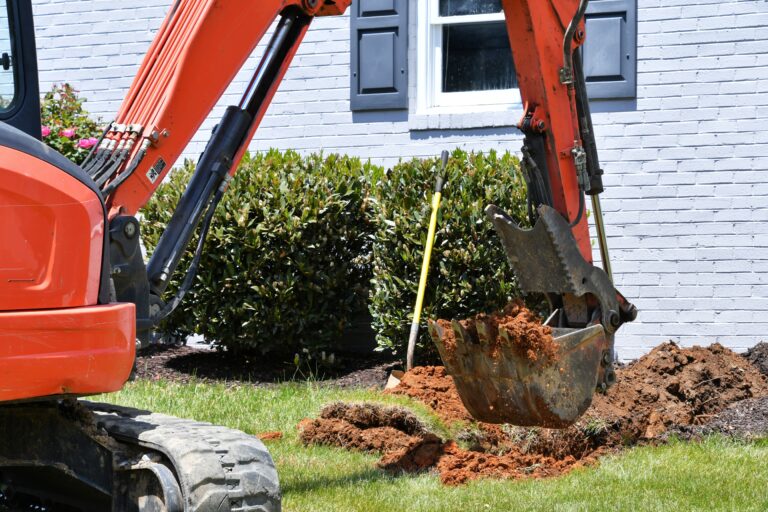Table of Contents
Hand Digging
Advantages of Hand Digging:
1) Precision and Control:
- Hand digging offers unmatched precision, making it the preferred method for tasks that require careful excavation. For example, when working near underground utilities such as water lines, gas pipes, or electrical cables, hand digging minimizes the risk of accidental damage.
- In archaeological excavations or conservation projects, where preserving the integrity of the site is critical, hand digging allows for meticulous removal of soil layer by layer, protecting delicate artifacts or structures.

2) Cost-Effective for Small Projects:
- The cost of hand digging is generally lower for small-scale projects, as it does not require expensive machinery or fuel. The primary expense is labor, which can be managed according to the project’s budget.
- For tasks such as garden landscaping, minor repairs, or small trench digging, hand digging provides an economical solution without the overhead costs associated with renting or operating heavy machinery.
3) Accessibility in Confined Spaces:
- Hand digging is particularly advantageous in areas where access is restricted or where machinery cannot operate. For example, in urban environments with narrow alleyways, inside buildings, or in spaces surrounded by existing structures, hand digging is often the only viable option.
- This method also allows for work in areas with uneven terrain, steep slopes, or densely vegetated sites where machinery might be impractical or cause excessive disruption.
4) Lower Environmental Impact:
- Hand digging has a relatively low environmental footprint. It does not produce the noise, emissions, or soil compaction that heavy machinery does, making it a more environmentally friendly option.
- In sensitive ecosystems or areas with strict environmental regulations, hand digging is often required to minimize damage to the surrounding flora and fauna.
Disadvantages of Hand Digging:
1) Labor-Intensive:
- Hand digging is physically demanding, requiring significant manual labor. This can lead to fatigue, injuries, and a slower pace of work, particularly in challenging soil conditions such as rocky or clay-rich ground.
- The reliance on human labor means that productivity is limited by the number of workers and their endurance, making it less suitable for large-scale projects.
2) Time-Consuming:
- Due to its manual nature, hand digging is much slower than mechanical excavation. What might take a machine a few hours could take several days or even weeks to complete by hand.
- For projects with tight deadlines or where time is a critical factor, the slow pace of hand digging can be a significant disadvantage.
3) Limited Depth and Volume:
- Hand digging is not practical for excavating deep trenches or large volumes of earth. The physical limitations of workers mean that reaching significant depths or removing substantial amounts of soil is both time-consuming and potentially unsafe.
- For deep foundations, large basements, or significant earthmoving projects, hand digging is simply not feasible without enormous labor resources and time.
Mechanical Excavation

Advantages of Mechanical Excavation:
1) Speed and Efficiency:
- Mechanical excavation can complete in hours what might take weeks by hand. For large-scale projects, this speed is crucial in keeping the project on schedule and within budget.
- Machinery like hydraulic excavators can dig deep trenches or large holes quickly, making them indispensable for projects like road construction, large foundations, and mass grading. If you’d like to explore more about regrading dirt, read our blog How to Build Up Soil and Regrade Around Your Foundation.
2) Capability for Large Projects:
- Heavy machinery is capable of excavating vast amounts of earth, reaching significant depths, and handling challenging soil conditions that would be impossible or impractical with manual labor alone.
- Mechanical excavation is essential for projects that require large-scale earthmoving, such as the construction of dams, highways, or large commercial buildings.
3) Reduction in Manual Labor:
- By relying on machines rather than manual labor, mechanical excavation reduces the physical strain on workers and lowers the risk of injury. This is especially important in environments where safety is a concern, such as in unstable soil conditions or when dealing with large quantities of earth.
- Fewer workers are needed to operate the machinery compared to the number required for a large hand-digging project, which can lead to savings on labor costs in the long run.
4) Consistency and Uniformity:
- Machines can achieve a level of consistency and uniformity in excavation that is difficult to match with manual labor. This is particularly important for projects that require precise grading or leveling over large areas.
- The use of advanced technology, such as GPS-guided machinery, ensures that the excavation meets exact specifications, reducing the risk of errors that could lead to costly rework.
Disadvantages of Mechanical Excavation:
1) High Initial and Operating Costs:
- The cost of purchasing or renting heavy machinery is high, as are the ongoing costs of operation, maintenance, and fuel. These costs can make mechanical excavation less attractive for small or medium-sized projects where the scale does not justify the expense.
- Specialized operators are required to handle the machinery, which adds to the labor costs and requires additional training and certifications.
2) Limited Precision:
- While machinery is excellent for large-scale earthmoving, it lacks the precision of hand digging. When working near existing structures, utility lines, or in areas where accuracy is critical, machinery can pose a risk of unintended damage.
- The size and power of the machinery make it difficult to perform delicate work, such as digging around tree roots or in areas with a high density of underground utilities.
3) Environmental Impact:
- The use of heavy machinery can lead to significant environmental disruption. Soil compaction, which occurs under the weight of the machinery, can damage soil structure, affect drainage, and harm plant roots.
- The noise and emissions produced by machinery contribute to pollution, making mechanical excavation less desirable in environmentally sensitive areas or where there are concerns about noise levels.
4) Accessibility and Space Constraints:
- Mechanical excavation requires sufficient space for the machinery to operate. In confined spaces or urban areas with limited room for maneuvering, the size and bulk of the equipment can be a significant limitation.
- Steep slopes, uneven terrain, or heavily wooded areas may also pose challenges for machinery, making it difficult or impossible to use mechanical excavation effectively.
Conclusion
Choosing between hand digging and mechanical excavation depends on a variety of factors, including the scale of the project, the need for precision, the available budget, and environmental considerations. Hand digging is a highly effective method for small, precise tasks, particularly in areas where access is restricted or where environmental impact needs to be minimized. However, it is labor-intensive, time-consuming, and not suitable for large-scale projects.
On the other hand, mechanical excavation is the go-to choice for large projects where speed, depth, and volume are key concerns. It offers efficiency and capability that manual labor cannot match, but at a higher cost and with potential drawbacks in terms of precision and environmental impact.
In many cases, the best approach may involve a combination of both methods, using hand digging for delicate or confined areas and mechanical excavation for more extensive tasks. Ultimately, the decision should be informed by a careful assessment of the project’s specific needs, balancing cost, time, precision, and environmental impact to achieve the best possible outcome. For more detailed information and tailored advice, visit our page on digging. For support on your next hole digging and trenching labor project, please feel free to reach out through our contact form, and our team will be happy to help.



